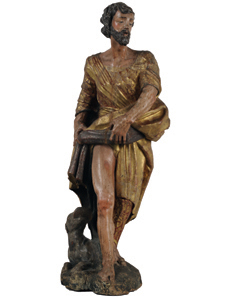Saint Roch (Hall 20)

Alonso Berruguete, whose documented dates span from 1490 to 1562, is considered the most significant Spanish Mannerist sculptor from the 16th century. Trained as a painter and sculptor in Italy, the work of Michelangelo figured decisively in the development of his style.
This sculpture is a clear example of his formal stylistic characteristics. The figure turns in on itself, doing away with all tendencies toward a frontal approach. The anatomy here is nervous, the body charged with tension and movement. The artist's style is uniquely evident in the virtuosity of the hands and in the facial expression, which is slightly melancholic. The polychrome is of high quality.
Parallels have been drawn between this work and the Major altarpiece from San Benito's monastery in Valladolid. Now housed in the National Museum of Sculpture at the Colegio de San Gregorio in the same city, the altarpiece was sculpted by the artist between 1526 and 1532. These dates correspond more or less to the years when this work was created.
The cult of Saint Roch was widespread starting in the 15th century. His most recognizable attribute is the dog which fed him when he fell ill. The saint's help was sought against the plague and infectious diseases, as he was known for healing the sick along his various pilgrimages.


